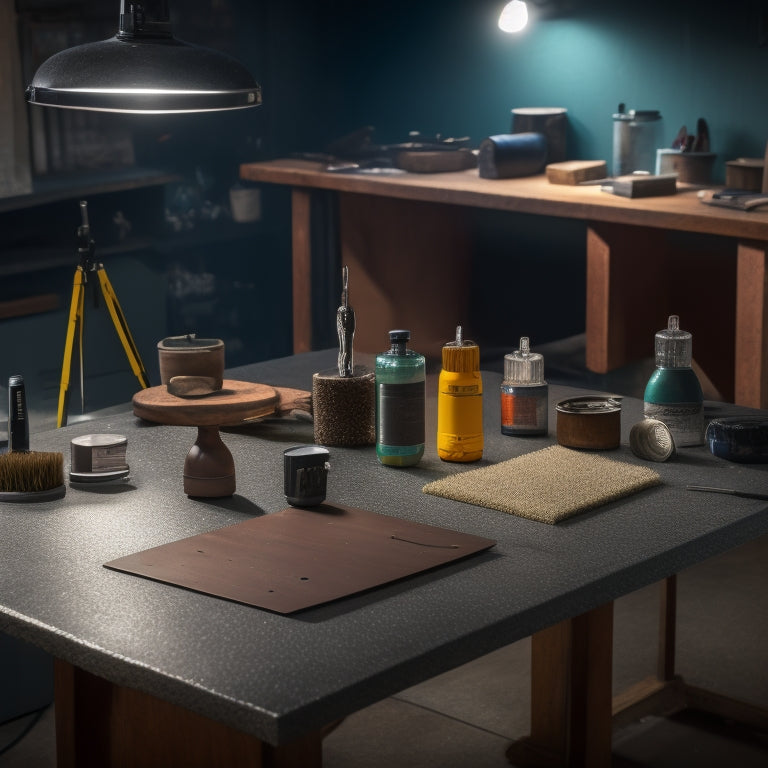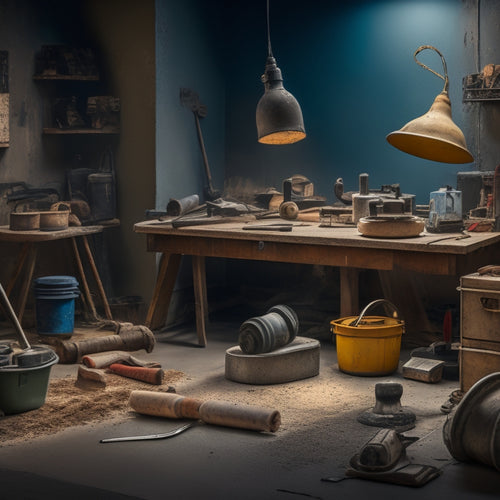
7 Best Tools for Polishing Concrete Countertops Perfectly
Share
When polishing concrete countertops, you'll need the right tools to achieve perfection. Start with diamond polishing pads, selecting metal-bond, resin-bond, or electroplated pads based on your project's demands. A variable speed polisher offers control and precision, while concrete grinders come in handheld, industrial, and walk-behind options. Edge profiler tools help create precise edges, and sealer applicator guns guarantee even application. Choose the right polishing compounds, such as aluminum oxide, cerium oxide, or diamond-based compounds, and don't forget high-speed polishers, polishing pads, and dustless vacuum systems for a flawless finish. Now, discover how to expertly wield these tools to reveal a showroom-worthy result.
Key Takeaways
• Diamond polishing pads are essential for effective polishing, with metal-bond, resin-bond, and electroplated pads suited for different stages of polishing.
• Variable speed polishers offer control and precision, adjusting speed to match specific techniques and pad performance for consistent results.
• Choosing the right tool depends on project demands, material compatibility, and countertop thickness, with considerations for weight, RPM, and concrete type.
• Edge profiling techniques require the right tools, such as edge profiler tools and bevel attachments, with attention to pressure and speed management for flawless edges.
• Polishing compounds, including aluminum oxide, cerium oxide, and diamond-based compounds, must be selected based on concrete type and desired shine level for effective results.
Diamond Polishing Pads Essentials
When selecting diamond polishing pads for your concrete countertop project, you'll want to prioritize pads with a high-quality diamond coating and a sturdy backing material to guarantee efficient and effective polishing. This is essential because the right diamond pad type can make all the difference in achieving a high-gloss finish.
You'll need to choose between metal-bond, resin-bond, and electroplated diamond pads, each suited for specific polishing techniques and stages.
Metal-bond diamond pads, for instance, are ideal for aggressive grinding and heavy material removal, while resin-bond pads are better suited for intermediate polishing and honing. Electroplated diamond pads, on the other hand, are perfect for fine polishing and final finishing.
Understanding the characteristics of each diamond pad type will enable you to select the right one for your project, ensuring a flawless finish.
Variable Speed Polisher Benefits
With the right diamond polishing pads in hand, you're now ready to harness the power of a variable speed polisher, which offers unparalleled control and precision to tackle even the most demanding concrete countertop projects. This versatile tool allows you to adjust the speed to suit the specific polishing technique you're using, ensuring ideal results. By varying the speed, you can effectively remove imperfections, scratches, and swirl marks, leaving a high-gloss finish.
When working with concrete countertops, variable speed polishers enable you to adapt to changing surface conditions, such as shifting from rough to fine polishing. This flexibility allows you to maintain consistent results, even on complex or irregularly shaped surfaces.
Additionally, the ability to adjust speed enables you to enhance the performance of your diamond polishing pads, extending their lifespan and reducing the risk of overheating. With a variable speed polisher, you'll have the confidence to tackle even the most intricate polishing techniques, knowing you have the precision and control to achieve flawless results.
Concrete Grinder Tool Options
When selecting a concrete grinder, you'll encounter various types, each suited for specific tasks and surfaces.
You'll need to take into account factors like the size of the area to be polished, the level of aggregate exposure desired, and the power source required.
Grinder Types Available
You'll find several types of grinders on the market, each designed to tackle specific concrete polishing tasks and deliver distinct results. As a concrete countertop polisher, understanding the different types of grinders available is essential to achieving the desired finish.
| Grinder Type | Description |
|---|---|
| Handheld Grinders | Lightweight, versatile, and perfect for small to medium-sized projects. Ideal for edge work and detail polishing. |
| Industrial Grinders | Heavy-duty, high-powered, and designed for large-scale commercial projects. Suitable for bulk material removal and heavy polishing. |
| Walk-Behind Grinders | Self-propelled, high-production grinders ideal for large, open areas. Great for removing old coatings and preparing surfaces. |
| Ride-On Grinders | High-performance, ride-on grinders designed for massive commercial projects. Suitable for high-volume material removal and polishing. |
| Dustless Grinders | Equipped with advanced dust collection systems, these grinders minimize mess and maximize efficiency. Ideal for indoor projects. |
When selecting a grinder, consider the project's scope, size, and desired finish. Each grinder type is suited to specific tasks, and understanding their capabilities will help you achieve professional results.
Choosing the Right One
By evaluating the project's unique demands and your personal preferences, you can narrow down the selection of concrete grinder tool options to find the ideal fit for your specific needs.
When choosing the right concrete grinder, you'll want to assess factors such as material compatibility, countertop thickness, and the level of polishing desired. For example, if you're working with a thin countertop, you may want to opt for a grinder with a lower weight and RPM to prevent damage.
On the other hand, if you're working with a thick, heavily-reinforced concrete countertop, you may need a more heavy-duty grinder with higher torque and RPM. Additionally, analyze the type of concrete you're working with, as some grinders are better suited for certain types of concrete.
By taking these factors into account, you can select a concrete grinder that will efficiently and effectively polish your concrete countertop to the desired level of shine.
With the right tool in hand, you'll be able to achieve professional-grade results and take pride in your work.
Edge Profiler Tool Applications
When you're working with concrete countertops, you'll need to master edge shaping techniques to achieve a professional finish.
With an edge profiler tool, you can create precise, curved, or angled edges that complement your design.
Edge Shaping Techniques
Edge profiling tools are essential for creating precise, rounded, or beveled edges on concrete countertops, allowing you to achieve a variety of edge shapes and profiles that enhance the overall aesthetic and functionality of the finished surface.
When it comes to edge shaping techniques, you'll want to master bevel edge shaping, a process that involves angling the edge of the countertop to create a sloping surface. This technique not only adds visual appeal but also helps to prevent chipping and cracking.
To achieve a beveled edge, you'll need to use an edge profiler tool with a bevel attachment, which allows you to precision-control the angle and shape of the edge. By applying edge finishing techniques, such as gradually increasing the angle of the bevel, you can create a seamless shift from the countertop surface to the edge.
With practice and patience, you'll be able to achieve professional-looking results that showcase your attention to detail and commitment to quality.
Profiling Concrete Edges
With the bevel edge shaping technique mastered, you can now focus on profiling concrete edges, where precise control over the edge profiler tool is essential to achieve a flawless change from the countertop surface to the edge.
This critical step requires you to select the right profile shaping method, tailored to your specific design goals. You'll need to adjust the edge profiler tool to match the desired edge finishing techniques, whether it's a subtle radius or a sharp, crisp edge.
As you begin profiling, maintain consistent pressure and speed to prevent unevenness. Keep the tool perpendicular to the edge to guarantee a smooth shift.
For complex profiles, break them down into smaller sections, working methodically to achieve the desired shape. Remember, precise control is key, so take your time and make adjustments as needed.
Concrete Sealer Applicator Guns
You'll find that concrete sealer applicator guns are an essential investment for achieving an even, consistent coat on your concrete countertops. When choosing a sealer applicator gun, consider the type of sealer you're using and the application technique you prefer. Different guns are designed for specific sealer types, such as water-based, solvent-based, or epoxy-based sealers.
| Sealer Type | Application Technique | Recommended Gun |
|---|---|---|
| Water-based | Spraying | HVLP (High Volume, Low Pressure) gun |
| Solvent-based | Rolling | Foam roller gun |
| Epoxy-based | Brushing | Brush-tip gun |
| Acrylic-based | Sponging | Sponge-tip gun |
Using the right applicator gun guarantees a smooth, even coat and helps prevent wastage. For example, an HVLP gun is ideal for water-based sealers, as it produces a fine mist that reduces overspray. A foam roller gun, on the other hand, is better suited for solvent-based sealers, as it allows for a more controlled application. By investing in the right sealer applicator gun, you'll achieve professional-looking results and take your concrete countertop game to the next level.
Polishing Compound Selection Guide
Selecting the right polishing compound for your concrete countertop project is essential, as it directly affects the final appearance and durability of the surface. This requires careful consideration of factors such as the type of concrete, desired level of shine, and equipment availability.
You'll need to choose from various polishing compound types, including aluminum oxide, cerium oxide, and diamond-based compounds, each suited for specific surface finishing techniques.
For instance, aluminum oxide compounds are ideal for honing and grinding, while cerium oxide is better suited for high-gloss finishes. Diamond-based compounds, on the other hand, offer superior cutting power and are often used for aggressive polishing.
When selecting a polishing compound, consider the type of concrete you're working with, as some compounds may not be compatible with certain concrete mixes. Additionally, think about the level of shine you want to achieve, as well as the equipment you have available.
Final Polish Tool Kit Must-Haves
To achieve a flawless, high-gloss finish, you need a well-stocked final polish tool kit that includes the right combination of specialized tools and accessories. A vital component is a high-speed polisher, such as a grinder or a burnisher, which allows you to refine the surface and remove any remaining scratches.
You'll also need a selection of polishing pads, ranging from coarse to fine, to gradually refine the surface and achieve the desired level of shine. Don't forget a dustless vacuum system to keep the workspace clean and minimize the risk of scratches.
When it comes to surface preparation, a scraper or a profiler is essential for removing old coatings, adhesives, or other substances that may interfere with the polishing process. Additionally, a densifier or a hardener can help to strengthen the concrete and improve its overall durability.
Frequently Asked Questions
Can I Use a Belt Sander for Polishing Concrete Countertops?
You're considering using a belt sander for polishing concrete countertops, but it's not the most effective technique.
Belt sanders are better suited for removing old coatings or rough grinding, not for achieving a high-gloss finish.
For concrete polishing, you'll want to explore alternatives like planetary grinders or rotary polishers, which provide more control and flexibility.
These tools allow for more precise technique and better results, ensuring your countertops turn out perfectly polished.
How Do I Remove Scratches From Polished Concrete Surfaces?
Coincidentally, you've reached the final hurdle in achieving a flawless concrete surface - removing scratches.
To tackle this, you'll need to employ effective scratch removal techniques. Start by identifying the scratch depth and type.
Then, select a suitable concrete repair product, such as a polymer-based compound or a metal-bonded diamond paste, to fill and refine the affected area.
Follow the manufacturer's instructions and take necessary precautions to avoid further damage.
With precision and patience, you'll successfully eliminate scratches and reveal a stunning, polished concrete surface.
Is It Necessary to Seal Polished Concrete Countertops?
You're wondering if sealing your polished concrete countertops is necessary. The answer is yes, it's essential.
Sealing protects your surface from stains, etching, and wear. You'll have options for sealant types, such as topical, penetrating, and hybrid sealers.
Sealing benefits include enhanced durability, ease of maintenance, and a glossy finish. By applying a sealant, you'll guarantee your polished concrete countertops remain in pristine condition, saving you time and money in the long run.
Can I Polish Concrete Countertops by Hand Without Machines?
You're about to commence on a labor of love, tackling DIY concrete polishing by hand. The thought of achieving a mirror-like finish without machines is tantalizing, but be prepared for a workout.
Hand polishing techniques will test your patience and endurance, but with the right approach, you'll be rewarded. Start with coarse grits, gradually moving to finer ones, and don't be afraid to get aggressive.
How Long Does It Take to Polish a Concrete Countertop?
When you're polishing a concrete countertop, you'll need to factor in the time it takes for each stage to complete.
Depending on the polishing techniques you choose, you can expect to spend anywhere from a few hours to several days.
Drying times between coats can range from 30 minutes to overnight, and each successive stage will build upon the previous one.
Conclusion
You've made it to the final step of polishing your concrete countertops.
With the right tools, you've transformed a rough surface into a stunning, glossy finish.
Did you know that the concrete polishing industry is expected to grow 10.2% annually from 2022 to 2027?
This growing demand highlights the importance of mastering the polishing process.
By incorporating the 7 essential tools discussed, you'll be well-equipped to deliver high-quality results that meet the increasing demand for polished concrete countertops.
Related Posts
-

Top Concrete Resurfacing Tools for a Pro Finish
When it comes to achieving a professional finish in concrete resurfacing projects, you require the right set of speci...
-

Why You Need Affordable Concrete Wall Construction Tools
You need affordable concrete wall construction tools to guarantee a profitable project, as the cost of equipment can ...
-

Top Mixing Tools for DIY Concrete Block Laying
When it comes to DIY concrete block laying, the right mixing tools are vital for a strong and durable structure. You'...


